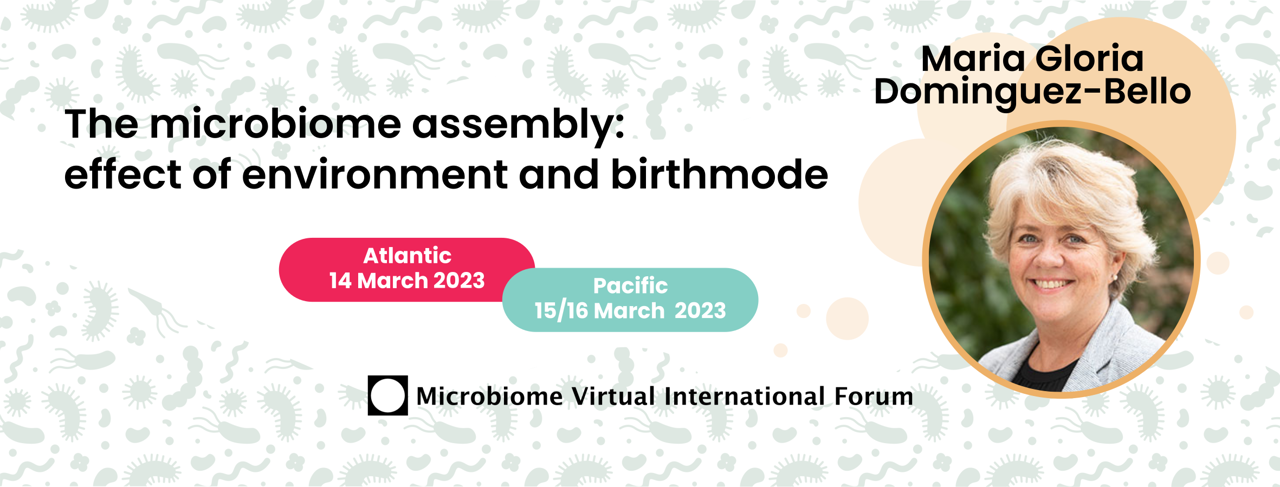Mammals develop in utero under sterile conditions and acquire the pioneer microbial colonizers during and after birth. C-section entitles missing the exposure to maternal microbes during birth and has long lasting effects on the infant microbiome structure. Labor experience and the environment can also have effects on the assembly of the early life microbiome.
Bio
Maria Gloria Dominguez-Bello is the director of the New Jersey Institute for Food, Nutrition, and Health, where she is leading a major organizational hub for interdisciplinary research that merges relevant disciplines to address crucial problems in nutritional sciences globally. Prof. Dominguez-Bello is also a Henry Rutgers Professor of Microbiome and Health. She studies early life assembly of the microbiome, effect of perturbations, loss of diversity with urbanization, and restoration approaches. She also looks at how Westernization changes environmental microbes and human exposures, integrating the fields of anthropology and architecture/urban studies into microbial ecology.
Selected Talks
1. Human milk oligosaccharides, antimicrobial drugs, and the gut microbiota of term neonates: observations from the KOALA birth cohort study
The infant gut microbiota affects childhood health. This pioneer microbiota may be vulnerable to antibiotic exposures, but could be supported by prebiotic oligosaccharides found in breast milk and some infant formulas. We sought to characterize the effects of several exposures on the neonatal gut microbiota, including human milk oligosaccharides (HMOs), galacto-oligosaccharides (GOS), and infant/maternal antimicrobial exposures. We profiled the stool microbiota of 1023 one-month-old infants from the KOALA Birth Cohort using 16S rRNA gene amplicon sequencing. We quantified 15 HMOs in breast milk from the mothers of 220 infants, using high-performance liquid chromatography-mass spectrometry. Both breastfeeding and antibiotic exposure decreased gut microbial diversity, but each was associated with contrasting shifts in microbiota composition. Other factors associated with microbiota composition included C-section, homebirth, siblings, and exposure to animals. Neither infant exposure to oral antifungals nor maternal exposure to antibiotics during pregnancy were associated with infant microbiota composition. Four distinct groups of breast milk HMO compositions were evident, corresponding to maternal Secretor status and Lewis group combinations defined by the presence/absence of certain fucosylated HMOs. However, we found the strongest evidence for microbiota associations between two non-fucosylated HMOs: 6’-sialyllactose (6’-SL) and lacto-N-hexaose (LNH), which were associated with lower and higher relative abundances of Bifidobacterium, respectively. Among 111 exclusively formula-fed infants, the GOS-supplemented formula was associated with a lower relative abundance of Clostridium perfringens. In conclusion, the gut microbiota is sensitive to some prebiotic and antibiotic exposures during early infancy and understanding their effects could inform future strategies for safeguarding a health-promoting infant gut microbiota.
Link to OA paper: https://doi.org/10.1080/19490976.2022.2164152
Twitter summary: https://twitter.com/penderslab/status/1612753647300911104
David JM Barnett, Martha Florencia Endika, Cynthia Klostermann, Fangjie Gu, Carel Thijs, Arjen Nauta, Henk Schols, Hauke Smidt, Ilja Arts, John Penders
Presenting author’s affiliation: Maastricht Centre for Systems Biology, and Maastricht University Medical Center, The Netherlands
2. Guts within guts: the microbiome of the intestinal helminth parasite Ascaris suum is derived but distinct from its host
Intestinal helminths are extremely prevalent among humans and animals. In particular, intestinal roundworms such as Ascaris suum affect more than 1 billion people around the globe and are a major issue in animal husbandry. These pathogens live in intimate contact with the host gut microbiota and harbor bacteria within their own intestines. Knowledge of the bacterial host microbiome at the site of infection is limited and data on the parasite microbiome is, to the best of our knowledge, non-existent. The intestinal microbiome of Ascaris suum was analyzed in contrast to the diversity and composition of the infected host gut. 16S sequencing of the parasite intestine and host intestinal compartments showed that the parasite gut has a significantly less diverse microbiome than its host and the host gut exhibits a reduced microbiome diversity at the site of parasite infection in the jejunum. While the host’s microbiome composition at the site of infection significantly determines the microbiome composition of its parasite, microbial signatures differentiate the nematodes from their hosts as the Ascaris intestine supports the growth of microbes that are otherwise under-represented in the host gut. Our data clearly indicate that a nematode infection reduces the microbiome diversity of the host gut and that the nematode gut represents a selective bacterial niche harboring bacteria that are derived but distinct from the host gut.
Link to OA paper: https://microbiomejournal.biomedcentral.com/articles/10.1186/s40168-022-01399-5
Twitter summary: https://twitter.com/vhjarquind/status/1604175016437854208
Ankur Midha & Victor Hugo Jarquin-Diaz
Freie Universität Berlin (AM), Max-Delbrück-Center for Molecular Medicine (VHJD), Germany
3. Functional and evolutionary characterization of unknown genes from uncultivated taxa
Over the last decades, the sequencing of environmental DNA by metagenomics has provided the genomes of thousands of uncultivated bacterial and archaeal lineages, revealing an enormous amount of previously unknown genes. Even though recent studies have highlighted the apparent importance of these novel genes, their overall significance is still largely unexplored. Here, we applied a comprehensive comparative genomics approach to identify high-quality novel protein families exclusive from uncultivated species, and characterized them from a functional, ecological and evolutionary point of view. For such a purpose, we computed protein families from a large multi-habitat metagenomic dataset covering 400M genes from 170k genomes spanning the prokaryotic phylogeny. We then applied strict quality and novelty filters to avoid incomplete genes, assembling artifacts, distant homologs and potential pseudogenes. This led us to uncovering 400K high-quality gene families exclusive from uncultivated taxa, twice the number of gene families in reference databases like EggNOG. These high-quality novel gene families are widespread within and across habitats, indicating their ecological value. They also spread out across the microbial phylogeny and are notably overrepresented in recently discovered taxa. Most remarkably, we found that 980 previously neglected protein families can accurately distinguish entire uncultivated phyla, classes and orders, likely representing synapomorphic traits. We inferred the putative functional roles of the high-quality novel gene families by reconstructing their genomic neighborhood and estimating their degree of functional context conservation. 18% of the novel protein families are present in phylogenetically conserved operon regions, in some cases involving key metabolic genes, suggesting they may take part in central microbial processes. In order to facilitate the characterization of novel gene families in relevant genomic contexts, we developed http://novelgenefamilies.compgenomics.org, which allows to browse and visualize the genomic neighbors of any of our novel gene family predictions. Overall, our work provides a global phylogenomic analysis of the largely uncharted repertoire of unique genes from uncultured prokaryotes, serving as a base resource for further investigations on their functional and ecological roles.
Link to OA paper: https://www.biorxiv.org/content/10.1101/2022.01.26.477801v1
Twitter summary: https://twitter.com/alvarordr/status/1487026445327155201
Álvaro Rodríguez del Río, Joaquin Giner-Lamia, Carlos P. Cantalapiedra, Jorge Botas, Ziqi Deng, Ana Hernandez-Plaza, Lucas Paoli, Thomas SB Schmidt, Sinichi Sunagawa, Peer Bork, Luis Pedro Coelho, Jaime Huerta Cepas
Presenting author’s affiliation: Centre for Plant Biotecnology and Genomics (CBGP), UPM-INIA
Highlights
4. Leveraging explainable AI for gut microbiome-based colorectal cancer classification
Studies have shown a link between colorectal cancer (CRC) and gut microbiome compositions. In these studies, machine learning is used to infer CRC biomarkers using global explanation methods. While these methods allow the identification of bacteria generally correlated with CRC, they fail to recognize species that are only influential for some individuals. In this study, we investigate the potential of Shapley Additive Explanations (SHAP) for a more personalized CRC biomarker identification. Analyses of five independent datasets show that this method can even separate CRC subjects into subgroups with distinct CRC probabilities and bacterial biomarkers.
Link to OA paper: https://doi.org/10.1186/s13059-023-02858-4
Ryza Rynazal, Kota Fujisawa, Hirotsugu Shiroma, Felix Salim, Sayaka Mizutani, Satoshi Shiba, Shinichi Yachida, Takuji Yamada
Presenting author’s affiliation: School of Life Science and Technology, Tokyo Institute of Technology
5. curatedMetagenomicData 3 allows meta-analysis of 22,710 human metagenomes in relation with host phenotype and health-outcomes and defines an oral to gut microbial introgression score
Publicly available microbiome data have become of sufficient scope for meta-analysis on a range of phenotypes, conditions, and health-related outcomes. This led to unprecedented results that were made possible thanks to the effort of integration of multiple microbiome cohorts. The wide-spread exploitation of public metagenomic dataset is however hampered by the lack of accessibility and standardization that are barriers to their use. To allow fast and convenient acquisition and harmonization of public microbiome data, we have developed curatedMetagenomicData (cMD) 3, an R/Biocoductor data-package deploying 22,710 publicly available human metagenomic samples from 94 cohorts and 42 countries. Samples in cMD 3 are uniformly profiled via the bioBakery 3 softwares MetaPhlAn 3 and HUMAnN 3.0, respectively for the taxonomic and the functional potential profiling. In addition, cMD 3 provides sample- and subject-related manually curated clinical and technical attributes organised in a coded vocabulary, allowing the easy retrieval and re-usage of microbiome datasets. In this resource paper, we present cMD 3. We use it to address several challenges in the current human microbiome epidemiology, with greater sample size and diversity of populations than previously possible. Via random-effects meta-analysis we identify species and metabolic features associated with sex (102 taxa, 15 Metacyc pathways, and 226 KEGG-Orthologs, Q < 0.01), age (91 taxa and 1,991 functions, Q < 0.01) or BMI (195 taxa and 1,018 functions, Q < 0.01). We investigate cross-disease, cross-cohort (15 diseases, 30 cohorts) species-level and pathway-level associations (34 species and 215 pathways, Q < 0.01). We then use the oral samples available through cMD 3 to define a simple “oral to gut introgression” score that can be easily calculated in any fecal sample as the summed relative abundance of 305 species identified from 425 oral metagenomes. This score is more frequently elevated than decreased in diseases (27 of 30 studies, P = 8.4 x 10-6, binomial test), representing a quantitative index of deviation from health-associated microbiome configurations. Together these analyses show the potential of the novel cMD 3, assessing the relationship between human microbiome and basic and clinical host outcomes and identifying modest but widely shared variation in human microbiomes that will serve as a reproducible and readily updatable reference.
Paolo Manghi, Lucas Schiffer, Davide Golzato, Jennifer Wokaty, Francesco Beghini, Chloe Anya Mirzayi, Sehyun Oh, Samuel David Gamboa-Tuz, Arianna Bonetti, Giacomo D'Amato, Rimsha Azhar, Gianmarco Piccinno, Kelly Eckenrode, Fatima Zohra, Valentina Giunchiglia, Marisa Keller, Anna Pedrotti, Ilya Likhotkin, Shaimaa Mohammed Elsafoury, Ludwig Geistlinger, Aitor Blanco-Miguez, Andrew Maltez Thomas, Moreno Zolfo, Marcel Ramos, Mireia Valles-Colomer, Sabrina Tamburini, Francesco Asnicar, Heidi E Jones, Curtis Huttenhower, Vincent James Carey, Sean Davis, Edoardo Pasolli, Nicola Segata, Levi Waldron
Presenting author’s affiliation: Department CIBIO, University of Trento, Trento, Italy

